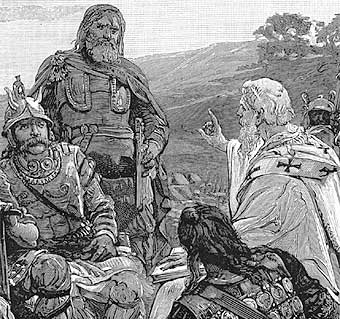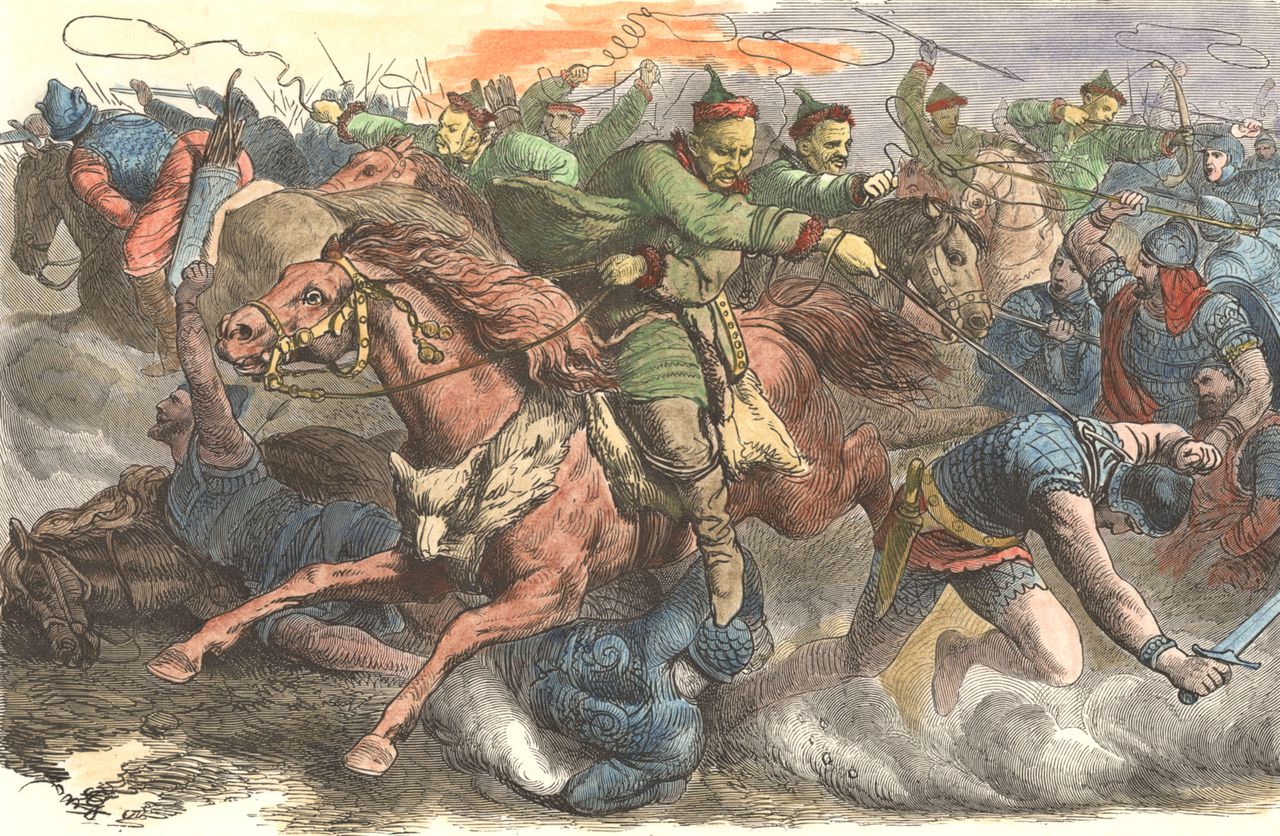Part 1: The Wolves and their Shepherd
"jah uswaurpun imma ut"
And they cast him out (John 9:34)
"jah gastop aftra sa handus is"
And his hand was restored (Mark 3:5)
The introduction of Christianity into Gothic society was rapid (compared to the other Germanic tribes), but not without opposition. In the mid-fourth century, the Goths were divided into two main groups: the Thervings on the Western side of the Danapris [1] and the Greuthings on the Eastern side.
The Greuthungs were lead by the great
Thiudans Airmanareiks [2]. Airmanareiks was known as a warlike leader, who repelled a number of incursions by Alan tribes. Although famed in folklore and media as a hero of resistance against steppe tribes, this reputation has come under increased scrutiny from modern historians. Archaeological evidence (primarily burial mounds) now suggest that some Alans were incorporated into Greuthung society and assimilated. Instead of insisting upon historical accuracy, many filmmakers have instead utilised the image of the legendary
Thiudans as political propaganda and to denigrate the peoples to the East. The Greuthungs were converted to Arian Christianity later than the Thervings, after the death of Airmanareiks.
Due perhaps to their greater proximity to the Roman Empire, the Thervings were unsurprisingly the first to seriously flirt with Christianity. Wulfila, a Gothic bishop and missionary. Although many historians have pointed out that Wulfila's parents were Cappadocian slaves, the fact that his name means '
Little Wolf' in Gothic and that he was known by a corrupted form of that name to the Romans suggests that he was born into Gothic society and identified as a Goth. During the 340s, Wulfila proselytised amongst the Goths, but fled to Moesia in 348 to escape the persecution of Christians by the Thervingi
Thiudans Aoreiks. Aoreik's son Athanareiks was also vehemently opposed to Christianity, believing that the adoption of the faith would lead to the destruction of Gothic culture. He led another, more serious round of persecutions between 367 and 378. This persecution was marked by a number of atrocities, the most well-known of which was the immolation of 26 martyrs in Taurica [3] on the order of the Chieftain Wingureiks in 375. Internally, the persecution of Christians was opposed by a faction headed by the Arian Frithugairns [4], who battled against Athanareiks. Despite Frithugairn's efforts, Athanareiks initially got the upper-hand in the war, although this changed when Frithugairn acquired the assistance of the Eastern Emperor Valens, a fellow Arian who intervened with troops and treasure on the side of Frithugairn. Whilst the war dragged on inconclusive for years, the accidental death of Athanareiks after he was pinned underneath his horse in a skirmish. None of the surviving manuscripts specify where Athanareiks was killed, although historians are almost certain it was somewhere in the
Harvatha [5].
With the defeat of the pagan faction in the Thervingi Civil War, the Christian community of the Thervingi flourished. The bishop Wulfilas devised the Gothic alphabet as a means of putting into writing the tongue of the
Gutthiuda[6]. Around 380 (he died in 383), Wulfila completed his translation of the Bible into Gothic, which did much to further the cause of Christianity within the Gothic lands, as well as promoting its adoption amongst many of the Gruthing nobility to the East of the Danapris. Notables which adopted these teachings included
harjatuga[7] Alatheus and Saphrax, an Alan by birth who was assimilated, with the rest of his tribe, into the Greuthungs. Vithimiris, who succeeded Airmanareiks, wasn't a Christian himself, but was tolerant of the Christian faith within his lands. He tasked himself merely with the maintenance of order and a balance of the interests of the pagan and Christian communities. Vithimireiks' reign only lasted a few years, dying in battle against Alan tribesmen. His son, Viderieks, was only a child upon his father's death, so the running of the tribe was done so primarily by Alatheus and Saphrax. Their influence led Viderieks to adopt Arian Christianity as the official religion of the Greuthungs. This necessarily involved the destruction of a number of pagan idols, but this loss of heritage resulted in the eventual establishment of a thriving and civilised kingdom. For many, the Christianisation of the Goths marks the beginning of the transition from tribal confederacy to nation.

Wulfila explains the gospel to Gothic chieftains
===
[1]Dnieper.
[2]King Ermanaric. 'Airmanareiks' appears to be a combination of an East Germanic form of the name 'Herman' and a Germanisation of the Latin 'rex'. Nevertheless, I decided to keep the whole name here, especially given that at least some of the Goths' very early history would only be accessible to them from Roman sources. Also, 'Thiudans' means 'leader of the people' (roughly) and assists in the characterisation of Gothic leaders of this period as closer to tribal chiefs than kings of centralised kingdoms.
[3]The Crimea.
[4]Fritigern.
[5]Carpathians.
[6]Gothic people (equivalent to Goth-
volk)
[7]General/Military Leader

